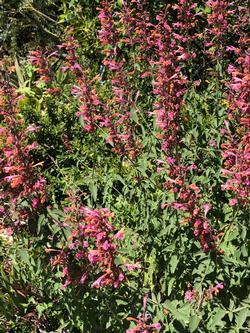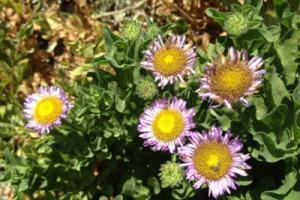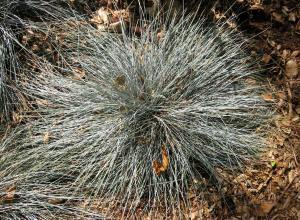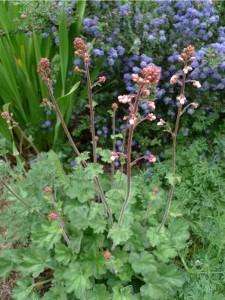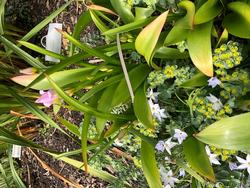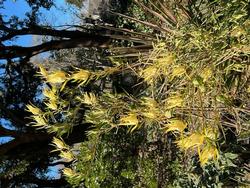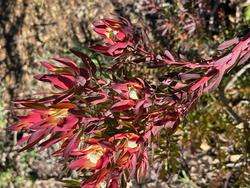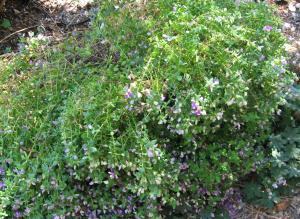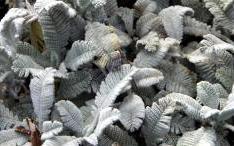Water Wise Plants
Here's a full list of all our water wise plants. You can also view an image gallery, or view the plants by categories.
Agastache ‘Acapulco Salmon and Pink’
Pronunciation
ah-ga-STAHK-ee
Common Name
Hummingbird mint
Plant Type
Perennial
Mature Size
2'-2.5' high x 1.5' wide
Water Requirements
Moderate: water weekly until the root ball is wet
Sun/Shade Requirements
Full to half sun
Wildlife
Flower Color
Orange and Pink
Where to See
Maintenance- Design- Planting Tips
Agastache ‘Acapulco Salmon and Pink’ is a beautiful accent plant for the late spring to early fall garden. It is more compact than most hummingbird mints and is densely covered by orange and pink flower spikes. The plant’s gray-green foliage is also a nice contrast to the brighter greens of most garden plants. Like many perennials, these plants die back during the winter. Hummingbird mints are only moderately drought tolerant. This plant does not flower well unless it is in full sun for half a day or more.
PADG notes: This specimen is planted where it gets morning sun and afternoon shade so it needs less water than recommended. During hot, summer periods, the plant is hosed weekly in addition to a once every three-week drip irrigation cycle. |
Anemopsis californica
Pronunciation
an-uh-MOP-sis kal-i-FOR-ni-kuh
Common Name
Yerba Mansa
Plant Type
Groundcover
Mature Size
2 wide x 0.33 - 1 ft(0.1 - 0.3 m) tall
Water Requirements
Moderate: water weekly until the root ball is wet
Sun/Shade Requirements
Full to half sun
Wildlife
Flower Color
White, Cream, Red
Where to See
Maintenance- Design- Planting Tips
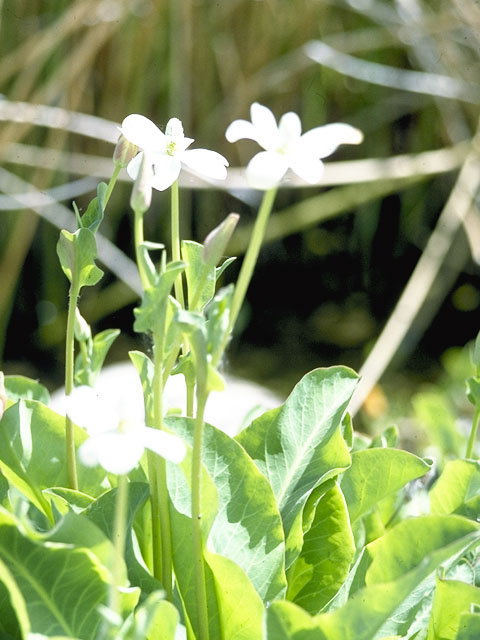
|
Artemisia douglasiana
Pronunciation
art-ee-MIS-ee-uh dug-las-ee-AH-nuh
Common Name
Douglas' Sagewort
Plant Type
Perennial
Mature Size
4 ft (1.2 m) wide x 8 ft (2.4 m) tall
Water Requirements
Moderate: water weekly until the root ball is wet
Sun/Shade Requirements
Half sun to shade
Wildlife
Flower Color
Cream, White, Yellow
Where to See
Maintenance- Design- Planting Tips
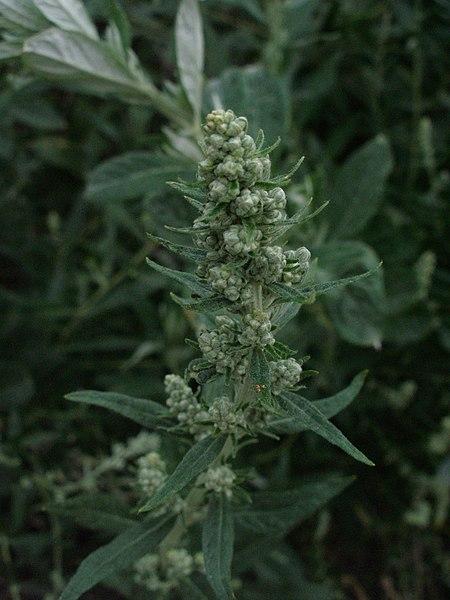
|
Erigeron glaucus ‘Wayne Roderick’
Pronunciation
er-IJ-er-on GLAW-kus
Common Name
Seaside Daisy ‘Wayne Roderick’
Plant Type
Perennial
Mature Size
1 ft. high and spreading up to 2 ft. wide
Water Requirements
Moderate: water weekly until the root ball is wet
Sun/Shade Requirements
Full to half sun
Wildlife
Flower Color
Pink to Lavender to Violet
Where to See
Maintenance- Design- Planting Tips
Erigeron glaucus ‘Wayne Roderick’ has a long bloom period if deadheaded regularly, with blooming starting in the spring and continuing into the fall. To keep this plant looking its best, prune back leggy growth to 1 or 2 inches in the late fall. The cultivar ‘Wayne Roderick’ is supposed to be longer lived, have larger blooms, and be more durable and heat tolerant than the species.
PADG notes: Our experience with Erigeron 'Wayne Roderick' has been very good, although we have noticed that the foliage burns in the summer unless given more frequent water. |
Festuca glauca
Pronunciation
fes-TOO-ka GLAW-ka
Common Name
Blue Fescue
Plant Type
Grass
Mature Size
1 ft high and 10 in. wide
Water Requirements
Moderate: water weekly until the root ball is wet
Sun/Shade Requirements
Full to half sun
Wildlife
Flower Color
Blue-green
Where to See
Maintenance- Design- Planting Tips
Blue fescue is a small, evergreen bunch grass with narrow blue-green leaves that form a mound. The fairly insignificant flowers appear in early summer.
This grass needs occasional water and good drainage. It tends to brown out in the middle, but can be divided and replanted to renew it. In a low water garden, these grasses seem to hold their blue green color better in the shade. |
Heuchera ‘Rosada’
Pronunciation
HEW-ker-ah
Common Name
Coral Bells ‘Rosada’
Plant Type
Perennial
Mature Size
3 ft. to 4 ft. wide with 1 ft. flower stalks
Water Requirements
Moderate: water weekly until the root ball is wet
Sun/Shade Requirements
Half sun to shade
Wildlife
Flower Color
Pink
Where to See
Maintenance- Design- Planting Tips
There are many kinds of Heuchera, but Heuchera ‘Rosada’ is a favorite. Introduced to the nursery trade by the UC Davis Arboretum, it is a cross between two different western U.S. native species.
Heuchera ‘Rosada’ prefers light shade and occasional to moderate water. With beautiful rosettes of low growing foliage and stalks of pink blooms, it is a favorite of woodland gardens. Removing the flower stalks when the plant finishes blooming is all the maintenance needed. Although these plants will grow in full sun, they will need more water to look their best. Plants grown in the shade can tolerate less water. UC Davis Arboretum selected Heuchera ‘Rosada’ for its Arboretum All-Stars designation, which identifies plants that are easy to grow, reliable, do not need a lot of water, and have few pest or disease problems. |
Ipheion uniflorum
Pronunciation
IF-ee-on yoo-nee-FLOR-um
Common Name
Starflower
Plant Type
Bulb
Mature Size
0.5' high x Spreads
Water Requirements
Moderate: water weekly until the root ball is wet
Sun/Shade Requirements
Full to half sun
Wildlife
Flower Color
Where to See
Maintenance- Design- Planting Tips
Ipheion uniflorum has low-growing green leaves and is covered with white star-shaped flowers in early spring. It dies down to the bulb after bloom and resprouts when fall and winter rains begin. It is a dainty and beautiful addition to garden edge. It reliably complements the early blooming narcissus and other spring flowers and requires little maintenance other than extra water if it does not rain during bloom.
|
Leucadendron salignum ‘Golden Tip’
Pronunciation
lew-kuh-DEN-dron sal-LIG-num
Common Name
Conebush
Plant Type
Shrub
Mature Size
4'-6' high x 4'-8' wide
Water Requirements
Moderate: water weekly until the root ball is wet
Sun/Shade Requirements
Full sun
Wildlife
Flower Color
Yellow
Where to See
Maintenance- Design- Planting Tips
Leucadendron salignum ‘Golden Tip’ is a structurally striking, upright shrub, with branches tipped with bright yellow bracts from winter into spring. Leaves are green but pick up a yellow hue during bloom time. Although considered drought tolerant, Leucadendrons require more water than most water wise plants. Even well-established plants can die during hot summers without enough water. PADG notes: This plant is watered every three weeks, but this is at the edge of their tolerance in the garden. They require little extra maintenance. |
Leucadendron salignum ‘Red Wing’
Pronunciation
lew-kuh-DEN-dron sal-LIG-num
Common Name
Conebush
Plant Type
Shrub
Mature Size
3'-4' high x 4'-6' wide
Water Requirements
Moderate: water weekly until the root ball is wet
Sun/Shade Requirements
Full sun
Wildlife
Flower Color
Red
Where to See
Maintenance- Design- Planting Tips
Leucadendron salignum ‘Red Wing’ is smaller than most leucadendrons and has deep red bracts from winter into spring. The green leaves pick up a red hue during bloom proving beautiful contrast in the mixed garden bed. Although considered drought tolerant, Leucadendrons require more water than most water wise plants. Even well-established plants can die during hot summers without enough water.
PADG notes: The plants are watered every three weeks at the Demonstration Garden, but this is right at the edge of their tolerance in the garden. They require little extra maintenance.
|
Polygala fruticosa 'Petite Butterfly'
Pronunciation
pol-ee-GAH-luh froo-tih-KOH-suh
Common Name
Petite Butterfly Sweet-Pea Shrub
Plant Type
Shrub
Mature Size
2 ft. to 3 ft. wide and tall
Water Requirements
Moderate: water weekly until the root ball is wet
Sun/Shade Requirements
Full to half sun
Wildlife
Flower Color
Purplish pink
Where to See
Maintenance- Design- Planting Tips
It's always nice to find a neat, round evergreen shrub that blooms a lot and doesn't get too big. Polygala fruticosa plays nicely in the perennial garden. Its flowers look a bit like sweet peas hence the common name 'Sweet-Pea Shrub'.
Cut back Polygala to about 10 inches above the ground in late winter to maintain its compact shape. Sunset’s Western Garden Book recommends providing regular water for Polygala. Several Master Gardeners have not found Polygala fruticosa to be long-lived in their home gardens. |
Ranunculus californicus
Pronunciation
ruh-NUNK-ew-loos kal-i-FOR-ni-koos
Common Name
California Buttercup
Plant Type
Perennial
Mature Size
6 in (15cm) wide x 0.6 - 2.3 ft (0.18 - 0.7 m) tall
Water Requirements
Moderate: water weekly until the root ball is wet
Sun/Shade Requirements
Full to half sun
Wildlife
Flower Color
Yellow
Where to See
Maintenance- Design- Planting Tips
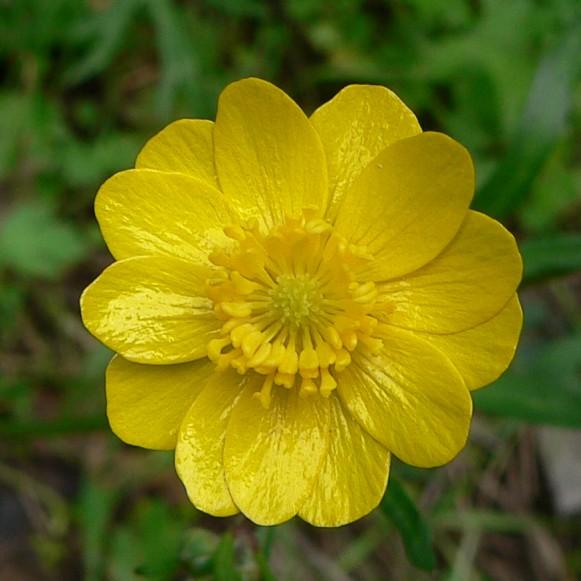
|
Rubus parviflorus
Pronunciation
ROO-bus par-VEE-floh-roos
Common Name
Thimbleberry
Plant Type
Shrub
Mature Size
4 - 8.2 ft. (1.2 - 2.5 m) tall
Water Requirements
Moderate: water weekly until the root ball is wet
Sun/Shade Requirements
Half sun to shade
Wildlife
Flower Color
White, Yellow
Where to See
Maintenance- Design- Planting Tips
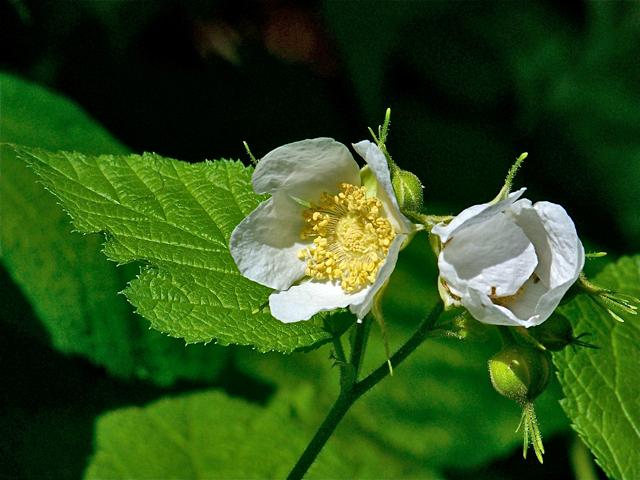
|
Tanacetum densum amani
Pronunciation
TAN-uh-SEE-tum DEN-sum AHM-an-eye
Common Name
Partridge Feather
Plant Type
Groundcover
Mature Size
6 - 8 in. high, spreading slowly to make a mat about 1 1/2 ft. wide
Water Requirements
Moderate: water weekly until the root ball is wet
Sun/Shade Requirements
Full to half sun
Wildlife
Flower Color
Yellow
Where to See
Maintenance- Design- Planting Tips
Tanacetum densum amani is a ground cover that is native to Turkey. Its leaves are silver and have a feathery texture.
PADG Notes: This plant is used as an edger in one of our beds. One drawback to the plant is the small yellow flowers that appear in late spring. Some people like them, but we cut them off. This plant has survived, but not thrived at in the Palo Alto Demonstration Garden. One reason might be that it likes more water than it receives. It is watered deeply every three weeks. We suspect this plant would look lusher in the summer with deep weekly watering. This plant is not easy to find in nurseries and gardens, but if you like the texture, Tanacetum densum amani is worth seeking out. |
Thalictrum fendleri var. polycarpum
Pronunciation
thuh-LIK-troom fend-LAH-ree
Common Name
Meadow Rue
Plant Type
Perennial
Mature Size
2 ft (0.6 m) wide x 2 - 4 ft (0.6 - 1.2 m) tall
Water Requirements
Moderate: water weekly until the root ball is wet
Sun/Shade Requirements
Half sun
Wildlife
Flower Color
Cream, Green, Yellow
Where to See
Maintenance- Design- Planting Tips
Meadow Rue is used in woodland and shade gardens as a perennial background plant. It has beautiful lacy blue-green foliage that unfurls from purplish shoots. The tiny unisexual flowers are produced atop 2 - 4 ft. tall stalks on separate plants. The male flowers are showier with dangling cream-yellow colored stamens; the female flowers are clusters of greenish pistils. It goes dormant in late summer when it is allowed to go dry. This Meadow Rue is easy to grow, in part sun to shade. It grows with occasional to regular irrigation, and can be drought-tolerant once established. |







